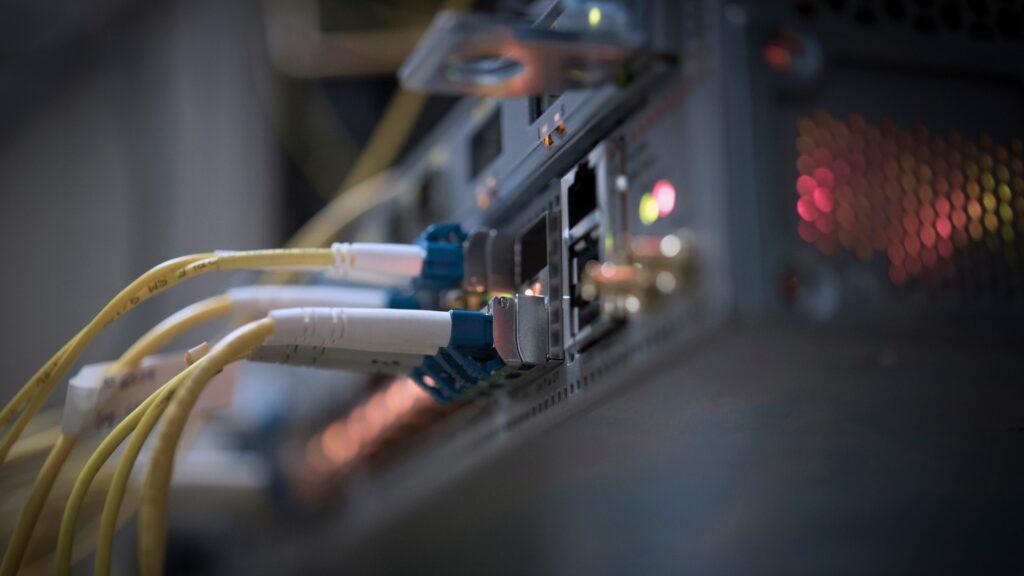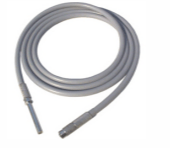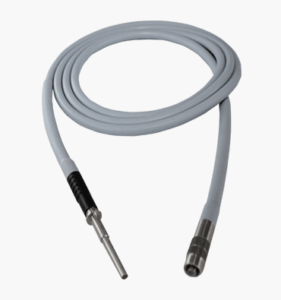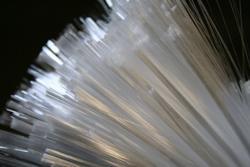Welcome to the blog on fiber optic cables for medical systems, brought to you by Medzell—an innovative B2B platform promoting Indian medical devices in emerging markets. In this blog, we will dive into the world of fiber optic cables, exploring their crucial role in medical equipment, comparing them with copper cables, identifying the perfect cables for surgical procedures, and unraveling the essential practices for cleaning, installation, and troubleshooting.
At Medzell, we are committed to empowering the healthcare industry with cutting-edge technologies. Through our futuristic B2B platform, we promote Indian medical devices, including top-quality fiber optic cables for medical systems, to emerging markets worldwide.
Introduction: Fiber Optic Cables for Medical Systems
Fiber optic cables play a critical role in medical systems, ensuring efficient and reliable transmission of data and images. These high-quality cables are specifically designed for medical applications, offering superior performance and precision. Fiber optic cables are the ideal choice for medical imaging and other advanced healthcare technologies. With the ability to transmit large amounts of data rapidly, these cables enable seamless and efficient communication, resulting in improved medical procedures and enhanced patient care. They provide secure and interference-free communication, allowing healthcare professionals to make accurate diagnoses and deliver optimal patient care. Upgrade your medical systems with fiber optic cables for seamless connectivity and enhanced performance. Experience the benefits of these cutting-edge cables in improving healthcare delivery.
Types of Fiber Optic Cables for Medical Systems
There are various types of fiber optic cables specifically designed for medical systems. Single-mode fiber optic cables find widespread use in long-distance transmissions and high-bandwidth applications. They are suitable for medical imaging and telemedicine. Multimode fiber optic cables are suitable for shorter distances and are often used in surgical procedures. Additionally, armored fiber optic cables provide extra protection against physical damage and are ideal for rugged medical environments. Hybrid fiber optic cables, combining both fiber and copper elements, are used for applications that require both power and data transmission. Choosing the right type of fiber optic cable is essential for ensuring reliable and efficient communication within medical systems.
Fiber Optic Cables vs. Copper Cables: Which is Right for You?
When comparing fiber optic cables to copper cables, there are several key distinctions to consider. Fiber optic cables excel in terms of bandwidth capacity, allowing for faster data transmission over longer distances. They are immune to electromagnetic interference, ensuring reliable signal integrity. Additionally, fiber optic cables provide increased security due to the difficulty of tapping into the transmitted signals. Copper cables are more affordable and easier to install. They also have the advantage of being compatible with existing infrastructure. Choosing between fiber optic and copper cables depends on factors such as data speed requirements, transmission distance, susceptibility to interference, installation feasibility, and budgetary considerations. Ultimately, it is crucial to evaluate the specific needs of the application to determine the most suitable cable type.
Finding the Perfect Fiber Optic Cables for Surgical Procedures
Surgical procedures demand the utmost reliability in fiber optic cables. In this section, we present a handpicked selection of the best fiber optic cables specifically designed for surgery. Explore their features, durability, and compatibility with surgical instruments.
When it comes to surgical procedures, finding the perfect fiber optic cables is crucial for seamless and accurate medical interventions. These specialized cables are designed to meet the demanding requirements of surgical environments, ensuring reliable and high-quality visualization during procedures. Factors to consider when selecting fiber optic cables for surgical applications include compatibility with surgical instruments, durability, flexibility, and image clarity. Additionally, it is essential to choose cables that provide optimal light transmission and are suitable for sterilization procedures. By selecting the right fiber optic cables, medical professionals can enhance the precision and efficiency of surgical interventions, leading to improved patient outcomes. Upgrade your operating room setup with the best fiber optic cables specifically designed for surgical procedures.
Essential Guide: Cleaning and Maintenance of Fiber Optic Cables
Proper cleaning and maintenance are vital to ensure optimal performance and longevity of your medical-grade fiber optic cables. Enhance the lifespan of your cables and maintain peak performance with our expert tips. Learn the essential practices for cleaning and maintaining your fiber optic cables.
Proper cleaning and maintenance of fiber optic cables are essential to ensure their optimal performance. Regular cleaning helps remove contaminants and debris that can degrade signal quality. When cleaning fiber optic cables, it is important to use lint-free wipes or cleaning sticks specifically designed for this purpose. Isopropyl alcohol or specialized fiber optic cleaning solutions can be used to gently clean the connectors and cable ends. Avoid touching the fiber optic connectors with bare hands as it can introduce oils or dirt. Additionally, it is crucial to handle the cables with care and avoid excessive bending or twisting to prevent damage. Regular inspections should be conducted to identify any signs of wear or damage. By following proper cleaning and maintenance practices, the lifespan and performance of fiber optic cables can be significantly extended.
Step-by-Step Guide: Installing Fiber Optic Cables in Medical Systems
Planning to install fiber optic cables in your medical systems? This step-by-step guide walks you through the entire installation process, from preparation to termination. Learn about the necessary tools, techniques, and safety measures to ensure a successful installation. Connect your medical equipment with reliable fiber optic cables following our detailed instructions. Installing fiber optic cables in medical systems requires careful planning and execution to ensure reliable and efficient connectivity. The steps to be followed are given.
- Assess the requirements: Determine the specific needs of your medical systems, such as the number of connections, transmission distance, and environmental conditions.
- Prepare the workspace: Clear the area and ensure a clean, dust-free environment for cable installation.
- Gather the necessary tools: Acquire tools like fiber optic cable cutters, strippers, fusion splicers, and termination kits.
- Measure and cut the cables: Accurately measure the required cable lengths and cut them accordingly, leaving some slack for ease of installation.
- Strip the cable ends: Use fiber optic strippers to remove the outer jacket and buffer coating, exposing the fiber strands.
- Terminate the connectors: Follow manufacturer instructions to attach connectors to the cable ends, ensuring precise alignment and secure connections.
- Test and verify: Use specialized equipment to test the installed cables for signal strength and integrity.
- Secure and label the cables: Safely route the cables, securing them with appropriate clips or adhesive mounts. Label each cable for easy identification and future maintenance.
By following this step-by-step guide, you can successfully install fiber optic cables in your medical systems, enabling seamless communication and data transmission.
Exploring the Latest Trends: Advancements in Fiber Optic Cables
Advancements in fiber optic cables have revolutionized various industries, including the medical field. These advancements have led to improved data transmission rates, increased bandwidth capacity, and enhanced signal quality. The development of advanced materials and manufacturing techniques has resulted in more durable and flexible fiber optic cables that can withstand harsh environments. Additionally, advancements in connector technology have made installation and maintenance easier. The integration of fiber optic cables with emerging technologies such as artificial intelligence and Internet of Things enhances their capabilities. This enables transformative applications in various industries. This integration enables faster data transfer, real-time connectivity, and seamless communication, paving the way for advanced healthcare systems, smart cities, and connected devices that drive efficiency and innovation. These advancements continue to drive innovation in medical imaging, telemedicine, and other healthcare applications.
Demystifying Compliance: Standards for Medical Fiber Optic Cables
Understanding regulatory compliance standards is crucial when selecting fiber optic cables for medical applications. Uncover the specific requirements, certifications, and guidelines that medical-grade fiber optic cables must meet. Ensure patient safety and reliable data transmission by choosing cables that adhere to the necessary standards.
Standards play a critical role in ensuring the safety, reliability, and performance of medical fiber optic cables. In the medical industry, fiber optic cables must adhere to specific standards to meet regulatory requirements and ensure compatibility. Standards such as ISO 13485 and IEC 60601 outline the quality management systems and safety requirements for medical devices, including fiber optic cables. Additionally, standards like IEC 60793 and IEC 60794 provide specifications for the optical fiber itself, covering parameters such as attenuation, bandwidth, and mechanical properties. Adhering to these standards helps ensure that medical fiber optic cables meet the necessary quality and safety benchmarks, providing healthcare professionals with confidence in their use.
Troubleshooting 101: Dealing with Common Fiber Optic Cable Problems
Encounter issues with fiber optic cables in your medical systems? Our troubleshooting guide is here to assist you. We provide solutions to common problems such as signal loss, connectivity issues, and cable damage. Learn how to diagnose, troubleshoot, and resolve fiber optic cable issues effectively. Get your medical systems up and running smoothly again with confidence.
Encountering problems with fiber optic cables can disrupt critical operations and data transmission. Signal loss, caused by factors like bending, tight radius, or dirty connectors, can be resolved by ensuring proper cable routing and cleaning. Connectivity problems may arise from improper termination or damaged connectors, requiring careful inspection and determination. Cable damage, such as cuts or breaks, can be addressed by splicing or replacing the affected section. It’s also important to address issues like excessive attenuation or dispersion, which can affect signal quality. Regular inspections, maintenance, and adherence to best practices can minimize and resolve common fiber optic cable problems, ensuring uninterrupted and reliable communication in medical systems.
Unveiling the Future: Fiber Optic Cables in Medical Innovations
Delve into the future of fiber optic cables in medical innovations. Explore how these advanced cables are revolutionizing medical imaging, robotic surgery, telemedicine, and more. Gain a visionary perspective on the breakthroughs and possibilities enabled by fiber optic cables.
Fiber optic cables have played a transformative role in medical innovations, revolutionizing various aspects of healthcare. In medical imaging, fiber optic cables enable the transmission of high-resolution images, facilitating accurate diagnostics and surgical interventions. Fiber optics are of use in minimally invasive procedures, such as endoscopy. This allows for precise visualization and improved patient outcomes. Additionally, fiber optic cables are integral in robotic surgery systems, enabling real-time transmission of high-definition video and precise control of surgical instruments. The integration of fiber optics with emerging technologies like augmented reality and telemedicine further expands the possibilities for remote diagnostics and remote surgical procedures. Fiber optic cables remain at the forefront of driving medical advancements and enhancing patient care due to their exceptional bandwidth, minimal latency, and reliable performance.
Ensuring Safety: Best Practices with Fiber Optic Cables
Safety is paramount when working with fiber optic cables in medical environments. Prioritize the well-being of patients, medical staff, and the equipment itself. Safeguard your medical systems effectively by following these essential guidelines. To ensure the safety of fiber optic cables in medical environments, follow these steps:
- Handle with care: Avoid excessive bending or twisting that could cause damage to the cables. Treat them delicately during installation, maintenance, and handling.
- Regular inspections: Routinely inspect cables for signs of wear, such as frayed or damaged fibers. Address any issues promptly to prevent further damage or signal degradation.
- Proper cleaning: When cleaning connectors, use lint-free wipes and specialized cleaning solutions to remove dust and contaminants. This helps maintain optimal performance and prevents signal loss.
- Correct installation: Follow proper installation techniques, including correct cable routing and avoiding sharp bends or tension that could compromise signal integrity. Ensure that connectors are properly seated and secured.
- Clear labeling: Label cables clearly to facilitate easy identification and minimize the risk of accidental disconnection or mishandling.
- Avoid potential hazards: Keep fiber optic cables away from heat sources, chemicals, and other potential hazards that could damage them or affect signal transmission.
- Training and awareness: Ensure that personnel working with fiber optic cables are trained on safety protocols and understand the risks involved. Promote awareness of safe practices and encourage reporting of any potential issues or concerns.
By following these steps, medical facilities can create a safe environment for fiber optic cable usage, ensuring the reliability and performance of critical healthcare operations.
Fiber Optic Cables from Leading Indian Manufacturers
DP-5191 Fiber Optic Light Cable
Introducing the DP-5191 Fiber Optic Light Cable by Kashmir Surgical India Pvt. Ltd., one of the leading manufacturers and global suppliers of fiber optic cables for medical systems in India. This high-quality light cable utilizes advanced proprietary optical fibers to ensure maximum illumination. It is designed with durable silicone sheathing, providing exceptional flexibility while minimizing weight. The cable is autoclavable, ensuring easy sterilization for medical applications. With dimensions of 4.5 mm x 7.5 ft, it offers optimal length and versatility for various medical procedures. The DP-5191 Fiber Optic Light Cable is the perfect solution for healthcare professionals seeking reliable and efficient light transmission in their medical equipment.
Fiber Optic Cable
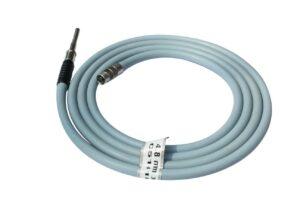 Manufactured by Meditrax Equipments, a trusted name in the industry, the Fiber Optic Cable is a top-notch product designed for medical systems. With a fiber diameter of 5 mm and a length of 2.3 m, this cable provides excellent light transmission capabilities. It is constructed using high-density German fiber, ensuring superior performance and reliability. The cable is Storz compatible, making it compatible with a wide range of medical devices and equipment. Whether used in surgical procedures or medical imaging, the Fiber Optic Cable from Meditrax Equipments delivers outstanding results, meeting the demanding requirements of the healthcare industry.
Manufactured by Meditrax Equipments, a trusted name in the industry, the Fiber Optic Cable is a top-notch product designed for medical systems. With a fiber diameter of 5 mm and a length of 2.3 m, this cable provides excellent light transmission capabilities. It is constructed using high-density German fiber, ensuring superior performance and reliability. The cable is Storz compatible, making it compatible with a wide range of medical devices and equipment. Whether used in surgical procedures or medical imaging, the Fiber Optic Cable from Meditrax Equipments delivers outstanding results, meeting the demanding requirements of the healthcare industry.
UL-4.8FOC – 4.8mm Medical Fiber Optic Cable
The UL-4.8FOC – 4.8mm Medical Fiber Optic Cable from UnivLabs Technologies Pvt. Ltd. is a versatile illumination light guide for medical applications. This cable, known for its exceptional durability, is designed to connect endoscopy light sources to endoscopes. It features autoclavable materials, ensuring longevity and easy sterilization. The use of high-temperature 3500C epoxy with the fiber enables compatibility with xenon, LED, and halogen light sources. The UL-4.8FOC cable is specifically engineered for medical environments, providing reliable and efficient light transmission. Its 4.8mm diameter offers flexibility and ease of use, making it a preferred choice for healthcare professionals worldwide.
Raw Glass Fiber
Welfo Fiber Optics presents Raw Glass Fiber, a high-quality product used in various medical applications. Manufactured using imported raw materials such as glass tubes and glass rods from Germany (Schott), this fiber optic bundle meets stringent quality standards. The Raw Glass Fiber offers enhanced light transmission, resulting in brighter and clearer medical lighting. It finds extensive use in endoscopy, surgical microscopy, dental treatments, and light therapy. Its excellent durability ensures a longer lifespan, while minimal changes in color and dispersion maintain high-quality illumination. Choose the Raw Glass Fiber for reliable and superior performance in your medical lighting needs.
Medzell: Empowering Indian Medical Device Manufacturers in Emerging Markets
Medzell, with its futuristic B2B platform, revolutionizes the promotion of Indian medical devices in emerging markets. The innovative platform connects medical manufacturers, suppliers, and buyers, facilitating seamless transactions and global market expansion. Medzell’s advanced features, including product showcases, real-time inventory management, and secure payment systems, streamline the procurement process and enhance business efficiency. By leveraging technology and providing a user-friendly interface, Medzell empowers medical device companies to reach a wider audience, establish valuable partnerships, and drive growth in emerging markets. Stay ahead of the competition with Medzell’s cutting-edge platform designed to transform the way medical devices are marketed and distributed.
